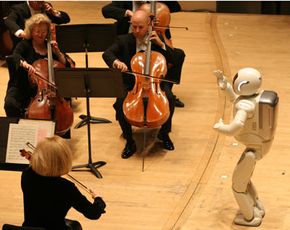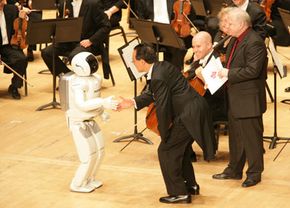On May 13, 2008, the Detroit Symphony Orchestra welcomed a very special guest conductor as part of the Power of Dreams Music Education Fund initiative. Unlike other guest conductors, this one didn't have an illustrious background in music. Nor was the conductor a well-known celebrity. In fact, the conductor didn't even have a heartbeat! It was the Advanced Step in Innovative Mobility robot, better known asASIMO.
A creation from the robotics division of Honda, ASIMO is ahumanoidrobot-- a robot that resembles a human being -- capable of accomplishing tasks that most robots find very challenging. That includes everything from climbing up and down a set of stairs to running in a circle to maneuvering through a room filled with obstacles. ASIMO has the capability to move in a smooth and fluid way with one motion flowing into the next. But while overcoming challenges and moving smoothly is impressive, it's not on the same level as conducting an orchestra.
Advertisement
There seems to be an inherent disconnect between robotics and music. For many people, music has an emotional component. Whether it's a musician expressing sorrow by playing a mournful requiem or a group of children bouncing along to a chipper tune, music and mood seem to go hand-in-hand. But ASIMO can't experience emotions or moods. As a robot, ASIMO can only receive input and make calculations or respond to commands given by an operator.
A good conductor can influence the mood of a piece of music by cueing musicians with gestures, facial expressions and even inhaling sharply. The relationship between the musicians and the conductor is an important aspect of any performance. But what happens when the conductor isn't even a human being?
How did ASIMO measure up? Will the robot be the next Leopold Stokowski? Find out in the next section.
Advertisement




